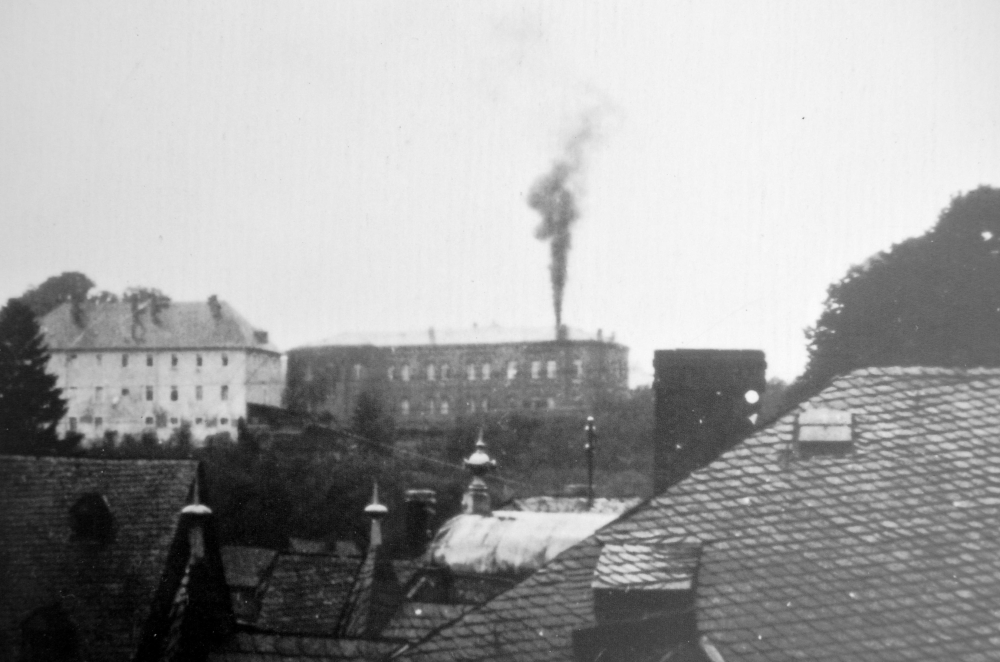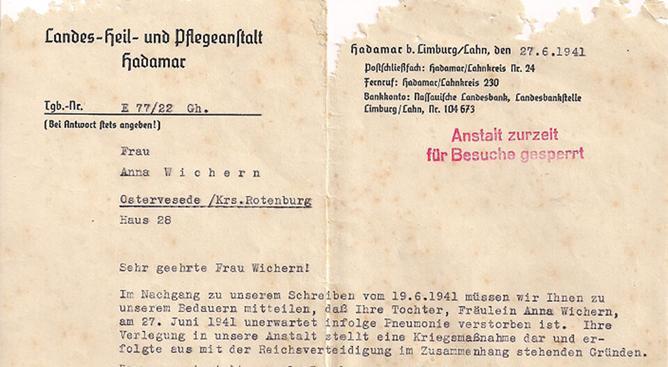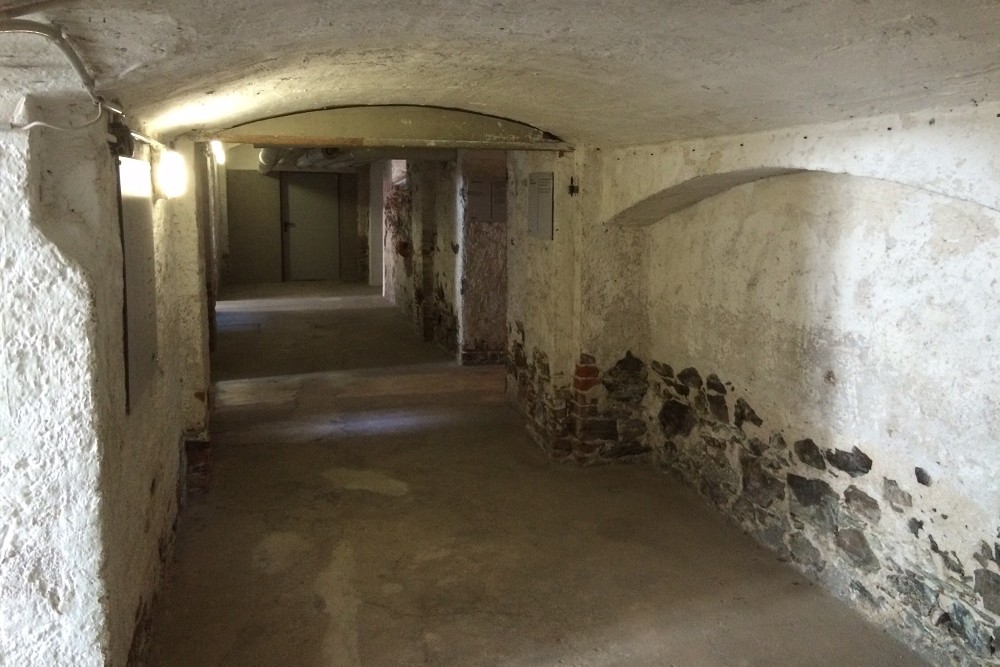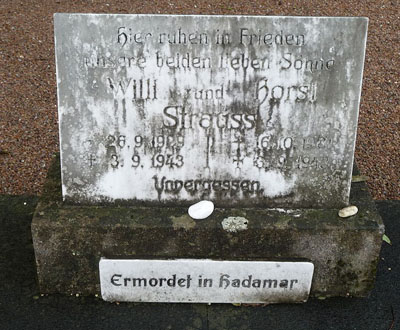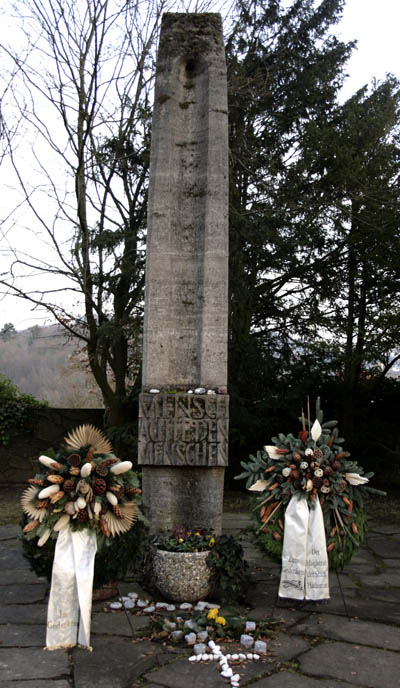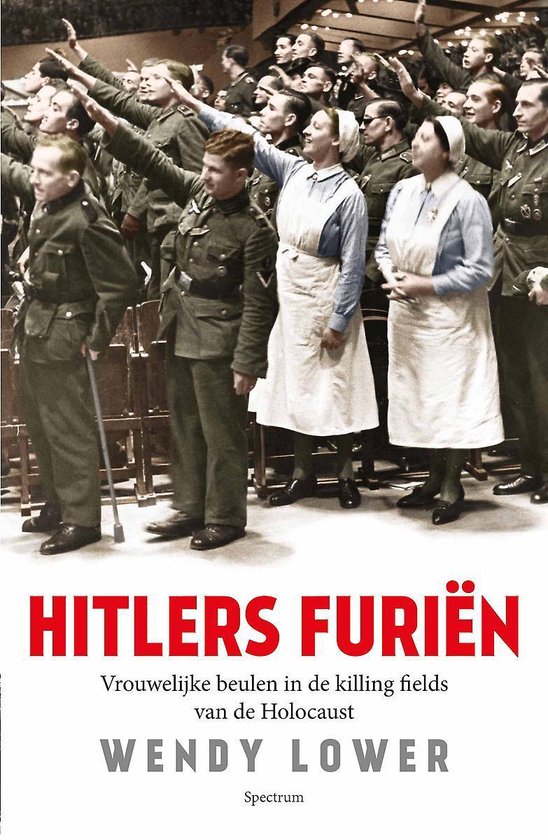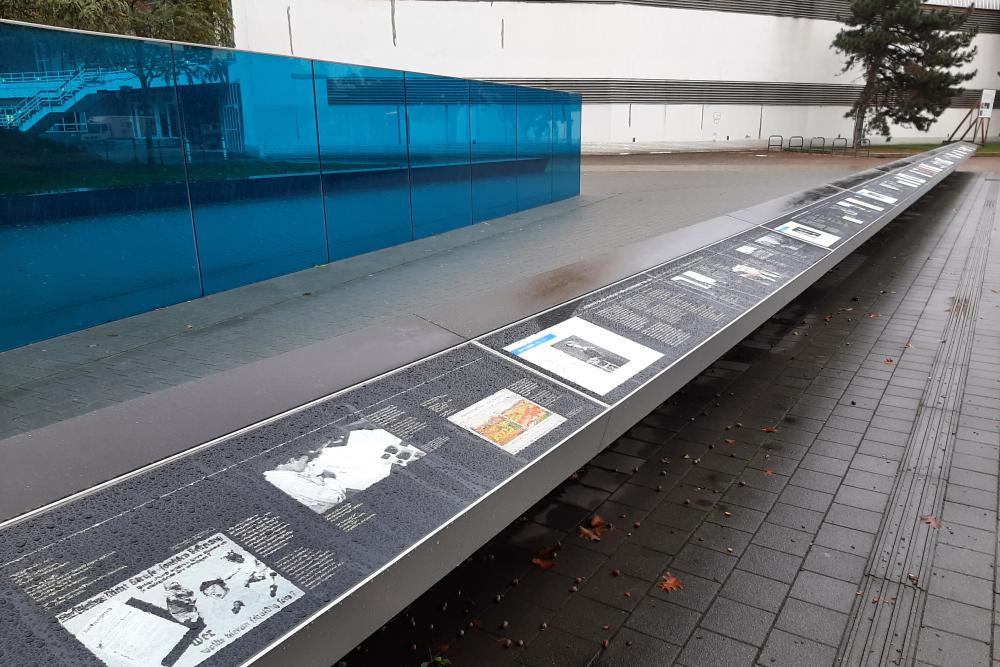Nazi clinic became death factory
The onset of World War II on September 1, 1939, was also the date that Adolf Hitler's euthanasia program was conceived. After the war that program would be referred to as Aktion T4, or simply T4.
Under Hitler’s euthanasia program ultimately approximately 200,000 chronically sick, or physically, mentally, or intellectually disabled persons were killed. Amongst them were children and babies. An estimated additional 100,000 individuals, mostly prisoners of Eastern Europe and Jewish prisoners, were also murdered under the program.
People with disabilities were considered "lebensunwertes Leben", unworthy of life and therefore inferior or useless, and a threat to the public health of the German people who, as per Nazi ideology, ultimately had to be "racially pure and strong" — people who could work and contribute. People with disabilities could not work and were considered a burden to the German Reich.
The authorization for active euthanasia – addressed to Philipp Bouhler, chief of the Führer's Chancellery, and to Hitler's personal physician Karl Brandt – was signed by Hitler at the end of October 1939 but came into effect retroactively on September 1, 1939, thereby, legally - and symbolically - connecting the euthanasia program to the war effort. The measure was now portrayed as something that could be justifiably used as a necessary part of the war effort. This was another example of how the Nazis created cover for their morally and legally indefensible acts.
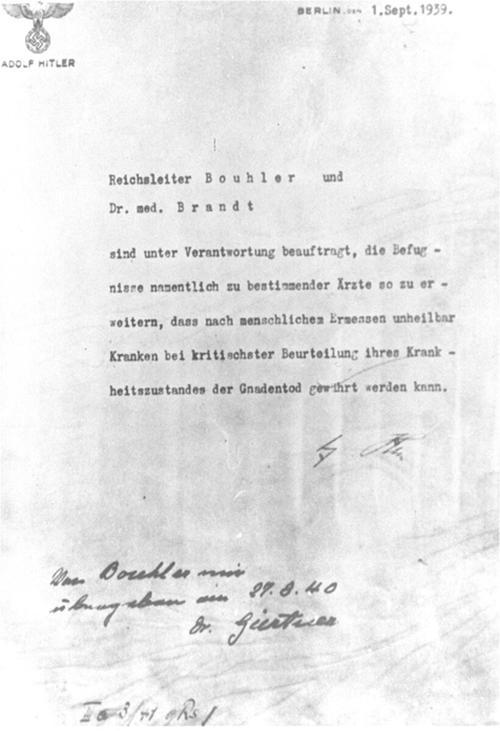
The letter of authorization signed by Hitler in 1939. Original versions of this document are preserved in archives such as the Bundesarchiv. Source: United States Holocaust Museum
The authorization empowered physicians and support personnel to label individuals as "incurably sick" and to give them a "Gnadentod" (mercy killing). The euthanasia program was to be top secret and its true shape obscured to lessen the legal threat and, above all, the moral threat. The authorities involved employed expressions such as "Behandlung" (treatment or special care) or "Gnadentod". Initially, the processes were managed by "innocent" institutions such as the Gemeinnützige Stiftung für Anstaltspflege (Foundation for Charitable Institutional Care).
In this bureaucratic killing machine, the Landesheilanstalt Hadamar (Hadamar State Hospital) became a central player, and with that the fate of a previously everyday and unobtrusive nurse was sealed.
Definitielijst
- Führer
- German word for leader. During his reign of power Adolf Hitler was Führer of Nazi Germany.
- ideology
- A collection of principles and ideas of a certain system.
- moral
- The will of the troops/civilians to keep fighting.
- Nazi
- Abbreviation of a national socialist.
Irmgard Huber: The merciless angel of Hadamar
While Adolf Hitler's plans to destroy the world were murderous, Irmgard Huber was at the heart of the repulsive implementation of the euthanasia program. This seemingly ordinary nurse was just one of many nurses who became part of a vast killing machine that the Nazis invented under their "Aktion T4" program. Irmgard not only participated in the implementation of "Aktion T4"; she also would become one of the key players in the administrative and medical processes of the program, but certainly also within the selection process that would prove to be fatal for thousands of patients who were mentally and physically disabled, mentally ill, or terminally ill.
Although there are few to no details about her childhood, and as was similar with many other Nazis who became murderers, Irmgard Huber had a normal childhood, without any notable events that could have predicted or foreseen her later role in Hadamar. Huber was born on July 9, 1901, in Attel-Reisach (Kreis Wasserburg/Inn) in Bavaria, eventually trained to be a nurse, and began her professional life in regular care facilities..
Her career started out like many others: first as a nurse at the Heilanstalt Gabersee, Bavaria (1920-1929). She passed her state nursing examination in 1925. She left this facility in 1930 to work at the Catholic School House Berlin-Wilmersdorf, and then transferred to the Kreiskrankenhaus Marienruhe, Hammelburg (Lower Franconia) in 1931. In 1932, she took a job as a private nurse in Storkow (Mark-Brandenburg). A fateful turn in her life came in 1932 when she became an employee of the Bezirksverband Nassau, which was the administrator of healthcare institutions like the Landesheilanstalt Hadamar.
By the end of the 1930s, Huber had become the head nurse of the recently established regular psychiatric institution, Hadamar, located near Limburg an de Lahn in the state of Hessen. Throughout these years, Nazi ideology became more prevalent in medical institutions resulting in the start in October of 1939 of the actual implementation of Hitler’s euthanasia program known as Aktion T4. Nurse Huber remained in her position, eventually actively participating in the program. In November 1940, she was seconded to it. In 1942 she became head nurse at Hadamar.
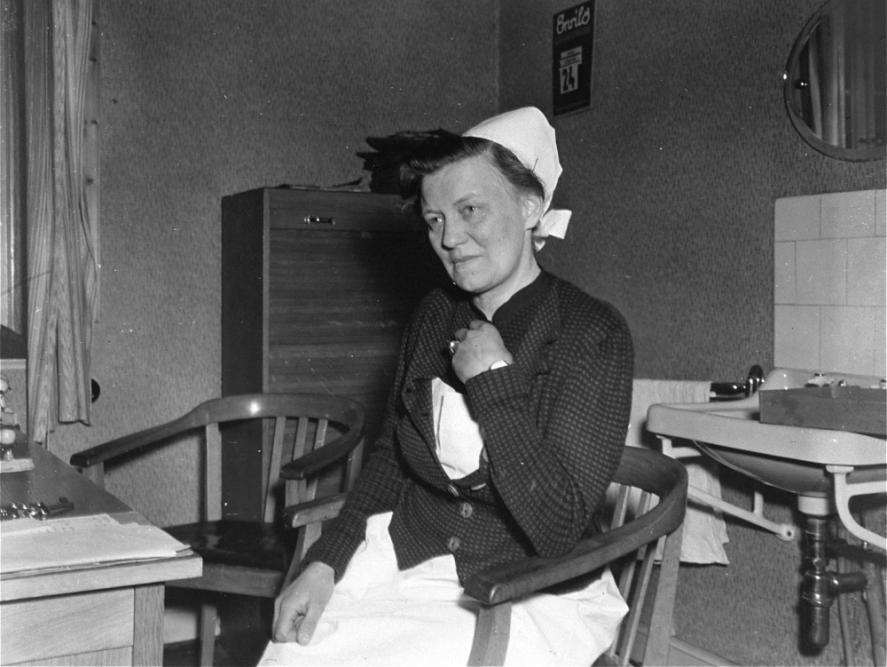
Irmgard Huber on April 7, 1945. Source: United States Holocaust Memorial Museum, Rosanne Bass Fulton
Definitielijst
- ideology
- A collection of principles and ideas of a certain system.
- Nazi
- Abbreviation of a national socialist.
The organization
On January 13, 1941, Hadamar opened as a fully-functioning euthanasia center. The center had a gas chamber, a crematorium, and a full administrative organization in which all mass murders were systematically recorded, falsified and concealed.
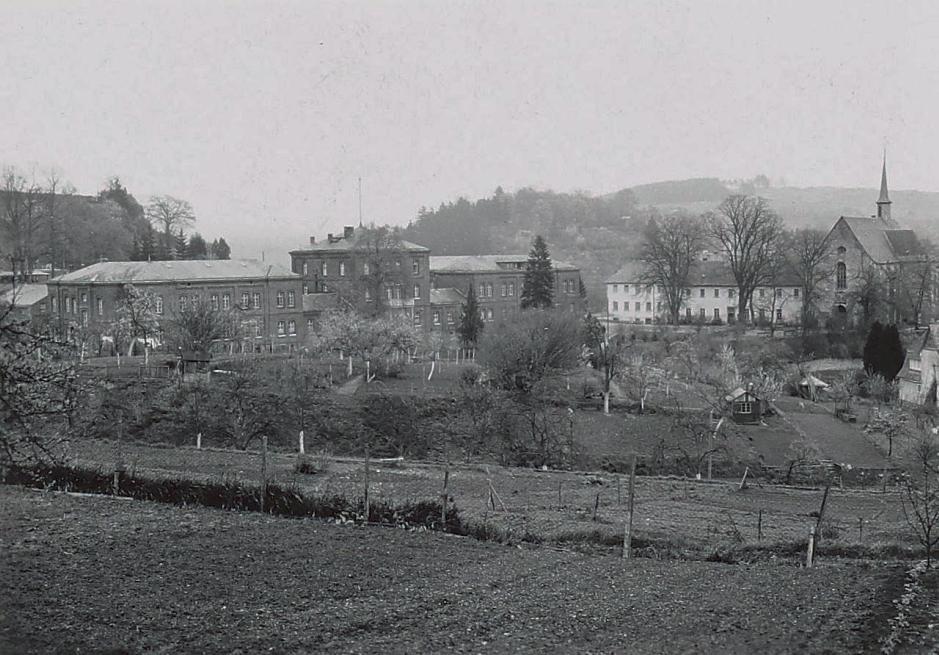
View of the Landesheilanstalt Hadamar, where the euthanasia center was located. Source: LWV-Archiv, F 12, No. 4
The Hadamar euthanasia center was the sixth and final euthanasia center established during the T4 program. The other five were: Grafeneck in Baden-Württemberg; Brandenburg at Brandenburg an der Havel; Hartheim, near Linz, Austria; Sonnenstein in Pirna, Saxony; and Bernburg in Saxony-Anhalt.
There were also nine so-called intermediate institutions (Zwischenanstalten). Located in the present-day state of Hesse were Herborn, Weilmünster, Idstein (Kalmenhof), and Eltville (Eichberg). In the present-day North Rhine-Westphalia was Galkhausen; in present-day Rhineland-Palatinate were Andernach and Schauen; and in present-day Baden-Württemberg were Wiesloch and Weinsberg.
These groups of intermediate institutions provided nothing more than collection and transfer facilities for patients who were brought in from the so-called source institutions (Ursprungsanstalten). From the intermediate locations, psychiatric and disabled patients, and later, prisoners of war and Jewish prisoners, were forcibly shuttled to one of the six euthanasia centers (Tötungsanstalten).
The organization which carried out the centrally controlled "euthanasia for adults" scheme was located at Tiergartenstraße 4 in Berlin, from which the program received its postwar moniker "Aktion T4," or "T4." The organization at Tiergartenstraße 4 was led by Hitler's personal physician, Karl Brandt, and the Chancellor's Officer, Philipp Bouhler.
Mental health institutions, or state sanatoriums or rehabilitation clinics in the German Reich, received registration forms, labeled "Meldebögen 1," (Registration Forms 1), and the institutions were expected to compile personal details about their patients.
Definitielijst
- Rhineland
- German-speaking demilitarized area on the right bank of the Rhine which was occupied by Adolf Hitler in 1936 after World War 1.
Procedure for Meldebögen 1
Meldebögen 1 (registration forms) were crucial in the selection and registration of victims. They contained questions on health history, potential working capacity, and other criteria regarding patients that the Nazis used to decide who would be killed. Once the Meldebőgen 1 had been filled out, they were reviewed by so-called experts ("Gutachters"), generally professors of psychiatry and institutional directors but later also lay persons. A total of 40 medical experts were designated, most of them established psychiatrists.
When the Meldebögen 1 had been received and copied, the forms were sent to three experts, who noted the decision in the form’s lower left box outlined in black. A red plus sign indicated the patient was to be euthanized. A blue minus sign indicated the patient could be spared, at least for a little while. If the judgement of the three experts was not unanimous, then the senior expert, the T4 medical director, made the final decision. Werner Heyde (1902-1964) was the medical director for the euthanasia program from 1939. In December 1941 Paul Nitsche (1876-1948) took over his deadly duties.
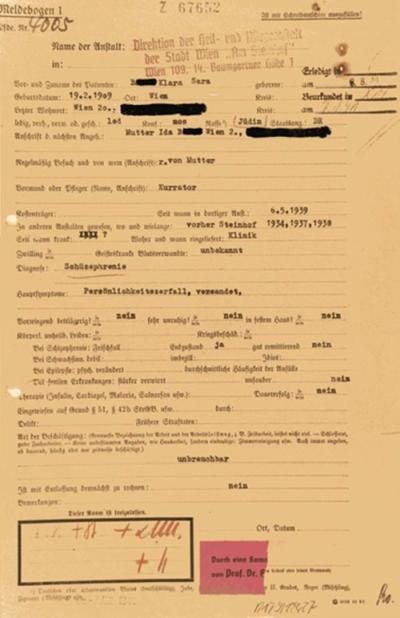
Registration form for Klara B. (1909–1940), completed at the Vienna sanatorium Am Steinhof, with processing notes and initials of the experts, 1939/40. Source: Bundesarchief Berlijn, R179/18427
Werner Heyde was a professor of psychiatry at the University of Würzburg. He also participated in medical killings in camps such as Buchenwald and Dachau. After the war, Heyde began living under the name Fritz Sawade. He worked as an expert doctor in sports medicine and psychiatry while even working as a judicial expert in some legal proceedings. Many of his colleagues were aware of his real identity. In 1956 he was exposed and arrested. Just before the beginning of his trial in 1964, he hung himself in his cell.
Paul Nitsche worked in Leipzig-Dösen, where he was the director of the Heil- und Pflegeanstalt Leipzig-Dösen, a clinic where methods of "silent euthanasia" were tested. From 1928 onward, he, too, was the director of Pirna-Sonnenstein, one of the other murder locations under T4. After the war, Nitsche was arrested and tried in Dresden in 1947 during the so-called "euthanasia trials." Nitsche was not an enthusiastic Nazi, but a dedicated proponent of 'racial hygiene' and a forceful supporter of 'psychiatry focused on only two possibilities: 'cure or fail.'' He was convicted of crimes against humanity and executed on March 25, 1948.
Other Meldebögen experts were Friedrich Mennecke (psychiatrist in Eichberg), Rudolf Lonauer (director of Hartheim and Bergburg euthanasia centers), Victor Ratka (psychiatrist at the Gauheilanstalt Tiegenhof in Gnesen (today Gniezno in Poland)), Gerard Wischer (psychiatrist at the Waldheim Hospital and Heil- und Pflegeanstalt), Carl Schneider (professor of psychiatry at the University of Heidelberg and the Wiesloch State Hospital), and Hermann Pfannmüller (psychiatrist at the Eglfing-Haar Hospital and Heil- und Pflegeanstalt in Munich).
Unfortunately, patients who had been continuously institutionalized for long periods of time, who did not have contact with their families, and who were classified as unable to work due to illness or disability often had little to no chance of survival. During the proceedings of "Aktion T4", more than 200,000 patients were listed by using Meldebögen. As many as 70,000 of those patients who received a report from the "Gutachters" (experts) were given a red plus sign and were murdered at one of the six specially equipped extermination centers and buried on the grounds of Hadamar.
The T4 euthanasia project was implemented ideologically, but most importantly, it was carried out bureaucratically and systematically. Even Hitler's family members were not exempt from his euthanasia program. Aloisa Veit, who was his second cousin, was murdered under his own euthanasia program. This is just one example of how the regime operated when individuals did not fit the ideal notion of racial purity or usefulness for the Third Reich. Aloisa was a mentally disabled woman who was housed in a psychiatric institution. Her mother was a relative of Adolf Hitler, and she was taken to a euthanasia center, most likely Hartheim or Sonnenstein, where she was murdered with carbon monoxide gas.
Hadamar was run by two doctors: Adolf Wahlmann and Walter Schmidt. By 1941, the Hadamar killing center had approximately 100 employees, including nurses, administration, and kitchen staff. Only 25 of these individuals would ultimately be held accountable and sought out for trial.
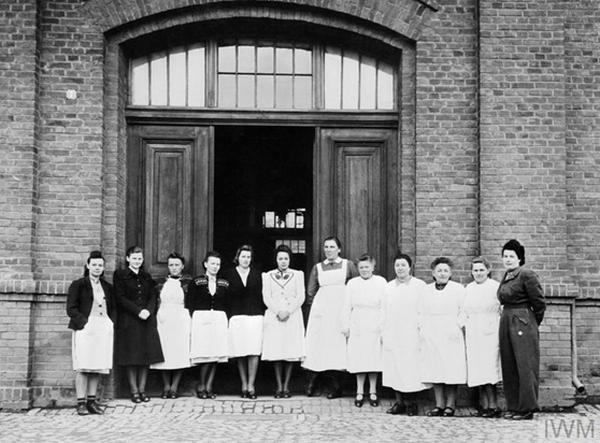
Some of the Hadamar nursing staff are pictured outside the facility after the arrival of American forces on April 5, 1945. Irmgard Huber, the clinic's head nurse, is likely fifth from the right. Source: Imperial War Museums
Definitielijst
- crimes against humanity
- Term that was introduced during the Nuremburg Trials. Crimes against humanity are inhuman treatment against civilian population and persecution on the basis of race or political or religious beliefs.
- Nazi
- Abbreviation of a national socialist.
- Würzburg
- German short range radar. Was used to guide searchlights, FLAK and guiding German night fighters.
Travel and Arrival
As of January 1941, patients were delivered to the Hadamar euthanasia center in buses that belonged to a transportation company of the T4 organization, the Gemeinnützige Krankentransportgesellschaft m. b. H. Once they arrived, the patients got off the bus inside a wooden bus garage which was built for this specific purpose. They then were escorted into the primary building and had to strip in a large hall. Administrative employees evaluated their personal details.
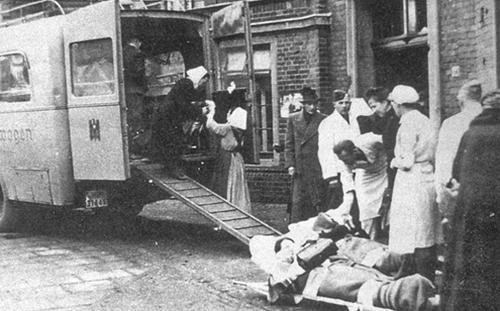
From January 1940, thousands of patients were transported by the T4 headquarters in buses of the ‘Gemeinnützige Krankentransport GmbH’ (Gekrat) to the six most important euthanasia locations. Source: United States Holocaust Memorial Museum
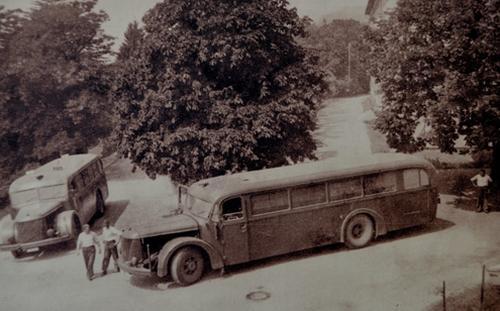
Arrival from the Eichberg Hospital near Wiesbaden at the euthanasia center in Hadamar. The bus windows were painted over to prevent passersby from seeing the people inside. Germany, between May and September 1941. Source: Wikimedia Commons
In the basement gas chamber, the patients were killed by carbon monoxide. Afterwards, their gold teeth were routinely removed. Gold teeth and fillings were collected and sent to the Reichsbank or used to finance the euthanasia program itself. When the American soldiers liberated Hadamar, they found jars full of gold teeth and fillings in the basement.
The bodies of patients with rare mental illnesses and neurological conditions were considered "scientifically interesting" and were often also subjected to brain removal before being burned. In such cases, the brains were preserved and sent to universities and laboratories under the pretense of neurological or psychiatric research. In essence, brains were studied to try to discover heritability of mental and physical conditions such as epilepsy or "antisocial behavior." The “researchers” also hoped to demonstrate the "inferiority of the Jews, Roma, and Slaves as well as disabilities." In reality it was eugenic research.
Amongst others, the universities of Heidelberg, Tübingen, Würzburg, and Munich regularly obtained brains from murdered patients for their pseudoscientific research. The role of universities and their entanglement illustrates the deep, unscrupulous path medical and scientific communities took in conjunction with the National Socialist extermination policy.
The often plundered bodies were burnt in the crematorium by permanent, paid Hadamar employees. The smoke from the cremation process could be seen from long distances, and, as local residents of Hadamar at the time reported, it could also be smelled.
Letters of Condolence
Families of murdered patients received what are referred to as “condolence letters,” typed by secretaries, which provided intentionally inaccurate information regarding the nature of the death, the time of death, and in some instances, the location of death. Urns were sent, but only at the request of relatives, who typically received an invoice for cremation and shipping costs for the urn, which in most cases did not contain the ashes of their murdered relative. And regularly urns were sent to families completely empty.
Definitielijst
- Jews
- Middle Eastern people with own religion that lived in Palestine. They distinguished themselves by their strong monotheism and the strict observance of the Law and tradition. During World War 2 the Jewish people were ruthlessly persecuted and annihilated by the German Nazis. . An estimated 6,000,000 Jews were exterminated.
- Würzburg
- German short range radar. Was used to guide searchlights, FLAK and guiding German night fighters.
Resistance against Hitler's Euthanasia program
People began to notice the large number of patients who were missing, and rumors of mass murder began to circulate. Relatives of the victims also began to suspect that their sick relatives had not died of natural causes and were suspicious of the falsified death certificates. Resistance from the churches began.
Clemens August von Galen, Catholic bishop of Munster, condemned the killing of innocent people. In a series of sermons in the summer of 1941, referred to most famously as Sermons Against Euthanasia, the most notable being on August 3, 1941, at St. Lamberti Church in Munster, the bishop explicitly and vehemently condemned the National Socialist euthanasia program. He denounced the systematic killing of people with mental or physical disabilities as a "perversion of basic Christian and human values. These poor, defenseless sick people are killed without guilt simply because their lives are considered "worthless.”s' wordt begrepen."[1][2]
He also condemned the lack of transparency with family members. Relatives simply received a form letter which stated that their relative passed away, that the body was going to be cremated, and that they could pick up the ashes. Von Galen called this a kind of organized deception, and mentioned Article 211 in the German criminal law, the Strafgesetzbuch (Criminal Code), and mentioned that Article 211 declared murder as a serious crime. "Whoever kills a human being, is guilty of murder and must be punished with death." Finally, he condemned the ideological basis of the euthanasia program; namely the idea of 'life worthy of living.' He called this teaching inhumane and un-Christian.
His protest was also supported by some Protestant organizations, although not so much by the official Protestant state church (the Deutsche Christen), which cooperated with the regime. Support came particularly from the Confessing Church ("bekennenden Kirche"), a resistance movement that was within German Protestantism and that opposed the Nazification of the church.
Clemens August von Galen’s sermons were distributed in underground pamphlets and even in international networks. The Nazi leadership did not want to arrest the bishop, presumably because they feared civil unrest. Von Galen's fierce resistance is said to have contributed significantly to the official termination of the euthanasia program.
Yet, when Hitler, under public pressure, officially ended this program on 24 August 1941, thousands of patients had already been murdered. However, even with the official termination of the program, the murders at Hadamar did not stop. From 1942 until its liberation by the American Third Army in March 1945, Hadamar was a "decentralized euthanasia center". Hadamar steadily continued the systematic killing of patients, but no longer used the gas chamber. More discrete actions were now required. From that date on, lethal injections or medication overdoses were administered. Many patients also died due to deliberate extreme neglect and starvation. Ultimately, approximately 14,500 people died in Hadamar between January 1941 and March 1945.
With the official end of the program in 1941, Hadamar's functions were broadened to include Eastern European forced laborers from Poland and the Soviet Union, of whom some were not medically disabled; they were just sick or otherwise not able to work. Hundreds of Jewish prisoners were also brought from forced labor camps to Hadamar and murdered there. These, too, were not disabled and often weren't even sick. They were murdered just because they were Jewish. Alcoholics, the homeless, single mothers, musicians, black marketeers, vagrants, prostitutes, and people at times dealing with maladaptive behaviors and labeled "antisocial" or "asocial" were also victims of the Nazi extermination policy.
As head nurse, Irmgard Huber was always directly involved in the euthanasia procedures over the entire Aktion T4 period. Internal correspondence between Hadamar with senior Nazi officials demonstrates how the operations were systematically coordinated. Death certificates were falsified and the paperwork required was skillfully falsified and staged in order to hide the real causes of death. Huber's actions demonstrate how thin the line can be between care and compassion, and murder and destruction.
Definitielijst
- Confessing Church
- German: Bekennende Kirche. Movement for revival within the German Protestant churches that developed during the 1930s from their resistance to Adolf Hitler’s attempt to make the churches an instrument of National Socialist (Nazi) propaganda and politics.
- Nazi
- Abbreviation of a national socialist.
- Resistance
- Resistance against the enemy. Often also with armed resources.
- Soviet Union
- Soviet Russia, alternative name for the USSR.
Exposure and Trial
When the 3rd US Army liberated Hadamar in 1945, they uncovered the horrors that had occurred there. The troops discovered mass graves and cremation ovens and vast amounts of documentation, detailing the systematic murders that had taken place. Upon examining the death records, American officials noticed irregularities in the death certificates. Staff testimonies confirmed how the descriptions of the deaths were distorted to conceal the active euthanasia of thousands of patients.
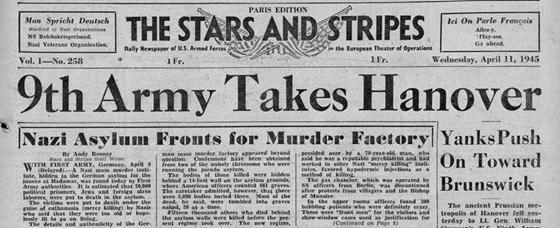
The discovery of Hadamar made headlines in several American newspapers on April 10 and 11, 1945. "Nazi Asylum Fronts for Murder Factory," reads the headline in The Stars and Stripes, the US Armed Forces newspaper.
It became clear that Irmgard Huber as head nurse was partly responsible for several key aspects of the euthanasia process at Hadamar. Huber was directly involved in falsifying death certificates stating natural causes of death when patients had been murdered. Despite her denials, Huber actually did have influence on which patients were to be euthanized, and she was involved in approving and processing the files. In addition, Huber was responsible for the distribution of lethal drugs (such as barbiturates) that were used to poison patients. In a few cases, nurses like Huber also participated in testing experimental forms of euthanasia.
Some patients survived their first dose of poison, resulting in further injections or more drastic steps like suffocation. In other cases, a shortage of lethal medications occurred and the clinic had to improvise and experiment with less discrete or "humane" treatments.
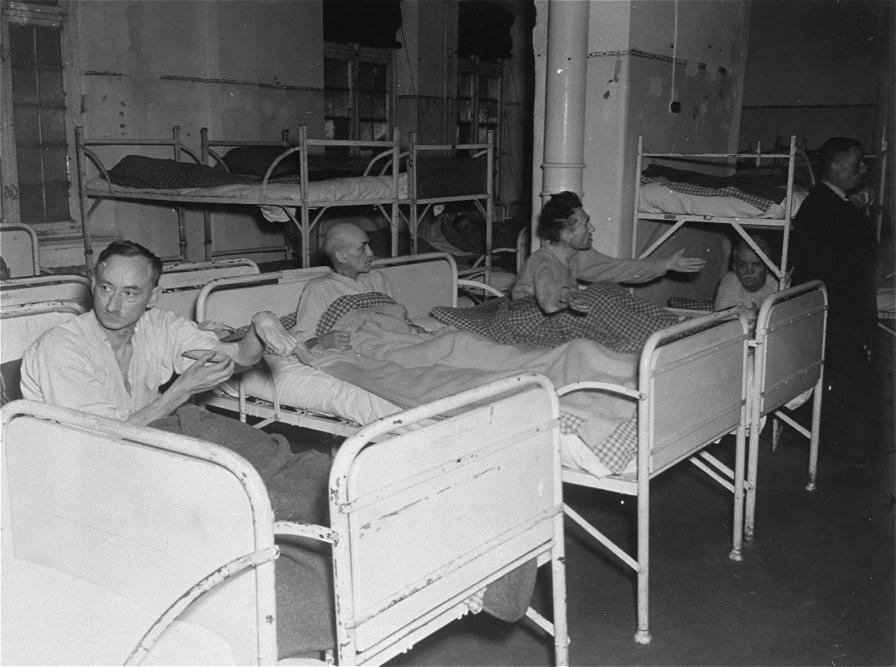
Three survivors rest in their beds at the Hadamar Institute. The photo was taken shortly after liberation, on April 5, 1945, by American military photographer Troy A. Peters Source: U.S. Army Photo
In the postwar years, historians began to study and archive Irmgard Huber's participation in Hadamar's euthanasia program. Evidence from correspondence between Hadamar and senior Nazi players confirmed that Hadamar employees including Huber had received instructions from Nazi leadership regarding euthanasia and were complying with the regime directives. Irmgard Huber's involvement and complicity became clearer as more archival documents and eyewitness statements were obtained. For example, after the reunification of Germany (October 3, 1990) new documents emerged that confirmed the scale of euthanasia and forever left no doubt about Huber's active role in it.
Definitielijst
- Nazi
- Abbreviation of a national socialist.
Huber's Justification
After the war, in 1948, Huber wrote that the patients were "exceptionally hopeless cases", and they were clearly in the end stages of schizophrenia and "Tiefstehende Geisteskranke”, at that time called "primitive mental illnesses" in German./i>”[3][4] With those statements, she justified her involvement by categorizing the victims as hopeless and worthless.
With regard to her trials in Hadamar before the American military court 1945-1947 and, in 1946, before the German civil court in Wiesbaden, Irmgard Huber defended herself by claiming she was simply an administrative executor. She said: "Ich habe nur Bestellungen ausgezahlt". It is likely that she meant, I only delivered or paid out orders of medicines or goods as she had no decision-making power in terms of who had been selected for euthanasia. She said she only followed orders from her superiors. She also claimed she never personally killed anyone. She herself would not have injected patients with lethal drugs but only monitored the supplies, and she would not have known that the euthanasia procedures in Hadamar were “systematic murders.” Her argument that she had no choice and that resisting the system could have endangered her own life was used by many perpetrators and sometimes considered by courts as mitigating factors.
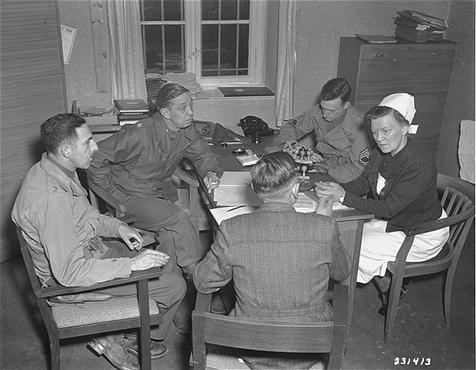
American war crimes investigators question Irmgard Huber in her office at the Hadamar Institute on April 7, 1945. The photo was taken by a U.S. Army photographer. Source: U.S. National Archives
Escape by Death
Friedrich Mennecke (a psychiatrist at Eichberg) was sentenced to death in 1946 as part of the "Eichberg Trial" in Frankfurt am Main, but before the sentence could be enacted, he died in Butzbach prison in 1947, presumably by suicide.
Rudolf Longader (the director of the euthanasia centers in Hartheim and Bergburg) in May 1945, just before the liberation of Bernburg by the Americans, poisoned his wife and two daughters and then committed suicide.
Victor Ratka (a psychiatrist in Gauheilanstalt Tiegenhof in Gnesen [Gniezno, Poland]) fled to eastern Germany just before Tiegenhof was liberated by the Red Army in January 1945. He worked as a medical assistant in the Pfaffenrode psychiatric hospital in Thűringen . Under the denazification process, he was considered a "collaborator" and was not charged. A warrant was issued for his arrest in 1961, but he was declared "haftunfähig" (unsuitable for detention) because of medical reasons. He died in 1966.
Gerhard Wischer (psychiatrist at the Heil- und Pflegeanstalt Waldheim was detained by Soviet occupying powers in October 1945 and held in Soviet camps No. 1 (Mühlberg) and No. 2 (Buchenwald). On June 23, 1950, he was sentenced to death during the Waldheim trials. He was executed on November 4, 1950, in Waldheim prison, almost precisely where he had previously murdered hundreds of patients by starvation and overdosing.
Carl Schneider (professor of psychiatry at the University of Heidelberg and Wiesloch State Hospital) was handed over in November 1946 by the American authorities to the German authorities in Frankfurt am Main, where he was to testify in the trial against Medical Director, Werner Heyde. He soon learned that he himself was under scrutiny as well and killed himself the next month.
Hermann Pfannmüller (psychiatrist at the Heil- und Pflegeanstalt Eglfing-Haar in Műnchen) was arrested, tried, and sentenced to five years imprisonment, which he did not serve in full and which he was in fact excused from for health reasons. He died of natural causes in 1961.
Definitielijst
- denazification
- Post war policy of the allies in Germany to punish Nazi war criminals and to remove known Nazis from positions of power or public service.
- Red Army
- Army of the Soviet Union.
Huber's conviction
Despite all her justifications, the American military court sentenced Irmgard Huber to 25 years of hard labor. In 1946, a German civilian court judged Huber to be guilty of complicity in at least 120 murders, extended her sentence by an additional eight years, but commuted her hard labor sentence to imprisonment. Alfons Klein, the former Hadamar director (Administrative Leader), alongside Heinrich Ruoff and Karl Willig, who were both nurses, were sentenced to death. They were hanged on March 14, 1946, in Bruchsal Prison, Landsberg am Lech.
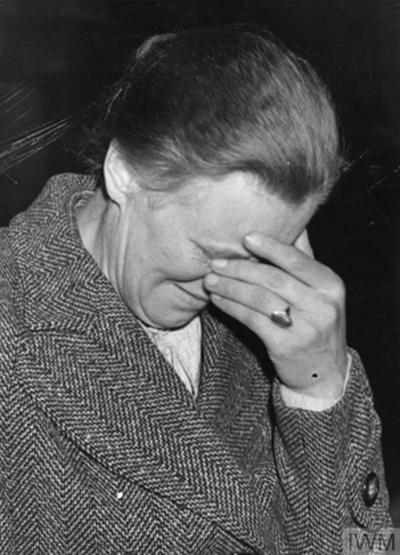
Irmgard Huber crying during her cross-examination on the last day of the trial, October 15, 1945. Source: Imperial War Museums
Chief physician, Adolf Wahlmann was sentenced to life in prison, but was released in 1953, due to poor health. Relatively few other nurses or staff members were sentenced to prison, but they were often released prematurely.
Of the 25 Hadamar employees who were eventually tried, Irmgard Huber received the longest sentence. However, of the total 33 years sentenced she served only six. According to records, Huber may have served her sentence in Bruchsal and Schwäbisch Hall (both in Baden-Württemberg), Landsberg am Lech in Bavaria (a prison for war criminals), and in Kassel, Hesse. She was released in 1952.
Vanished into anonymity
What happened to Huber after her release in 1952 remains a mystery. Although some Nazi criminals would write autobiographies or were involved in later legal lawsuits, Huber completely vanished from public life. There are no interviews, no memoirs and no government documents that shed light on the latter part of Huber's life. It appears that she returned to her birthplace in Attel-Reisach in 1952; but how she spent her remaining years will always remain unclear. Irmgard Huber died on December 4, 1974 in Wasserburg am Inn.
Notes
Definitielijst
- Nazi
- Abbreviation of a national socialist.
Information
- Article by:
- Carmèn L. Gopalrai
- Published on:
- 05-10-2025
- Feedback?
- Send it!
Related sights
Related books
Sources
- GEORGE, UTA e.a., Hadamar: Heilstätte - Tötungsanstalt - Therapiezentrum, Jonas, Marburg, 2006.
- LOWER, W., Hitlers furien, Spectrum, Houten, 2013.
- STENSAGER, ANDERS OTTE, ”Die Leute schrien: ’Ich will nicht sterben’”: Oberschwester Irmgard Huber, Kugelberg Verlag, Berlijn, 2024.
- Sandner, Peter, ‘Verwaltung des Krankenmordes: Der Bezirksverband Nassau im Nationalsozialismus’, 2003, op: www.lwv-hessen.de (PDF)
- encyclopedia.ushmm.org/content/en/article/deadly-medicine-irmgard-huber
- encyclopedia.ushmm.org/content/en/article/euthanasia-program
- www.t4-denkmal.de/das-meldebogenverfahren
- www.bundesarchiv.de/im-archiv-recherchieren/archivgut-recherchieren/nach-themen/euthanasie-im-dritten-reich
- ww2gravestone.com/irmgard-huber
- en.wikipedia.org/wiki/Irmgard_Huber
- www.t4-denkmal.de/das-meldebogenverfahren
- collections.ushmm.org/search/catalog/pa1046751
- alchetron.com/Irmgard-Huber
- zutphen4045.nl, De meedogenloze vrouwen van Duitsland in de Tweede Wereldoorlog (PDF)
- www.gedenkstaette-hadamar.de
- www.iwm.org.uk/collections/item/object/205089778
- www.inklusion-als-menschenrecht.de/nationalsozialismus/materialien/behinderung-krankheit-und-euthanasie-im-nationalsozialismus
- www.gesetze-im-internet.de
- www.verderopweg.nl/2021/05/06/de-leeuw-van-munster
- historiek.net/aktion-t4-het-nazi-eugenetica-programma
- www.vgn.nl/nieuws/gehandicaptenzorg-tijdens-woii-wat-gebeurde-er-eigenlijk
- www.normandy1944.info/holocaust
- mei1940.org/aktion-t4
- www.vrt.be/vrtnws/nl/drafts/jan-ouvry/75-jaar-geleden-de-ontdekking-van-hadamar-t4
- With thanks to Anne Palmer for her editorial work.
